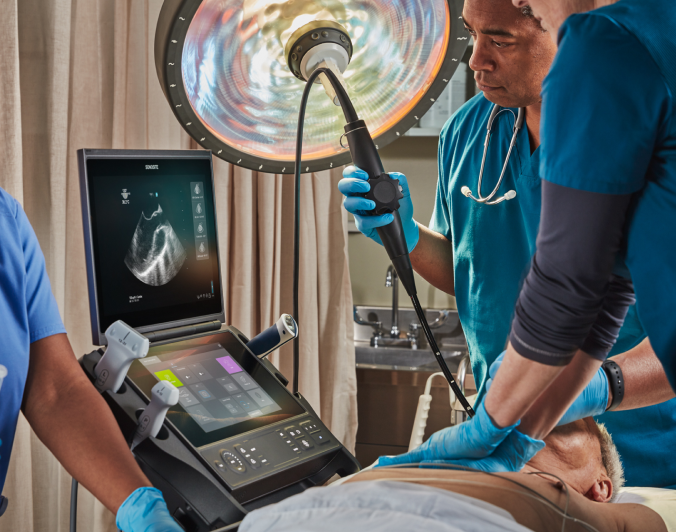Cardiac resuscitation at the point of care
Making clear decisions, sooner with TEU
Transesophageal Ultrasound (TEU) used in emergency medicine and critical care settings can help you treat each case with assurance at your side. Provide high-quality of care with confidence and encourage improved patient outcomes1.
Why implement a TEU cardiac resuscitation program?

For clinicians using TEU at the bedside, a clear cardiac window is necessary. The T8-3 TEU transducer offers access to the heart for more confidence in assessing, diagnosing, and treating patients when intervention is needed most.
With Sonosite's advanced image clarity and the T8-3's flexible design and optimized cardiac resuscitation exam type, it offers greater workflow efficiency to aid clinicians' efforts to improve patient outcomes.
Cardiac resuscitation exam type
The cardiac resuscitation exam displays a scan-along image protocol while the clinician is perfromaing an exam to assist them with achieving the images of four key cardiac visualizations:
Mid esophageal four chamber fire (ME4C)
Mid esophageal long view (ME LAX)
Transgastric mid-short axis (TG Mid SAX)
Mid esophageal bicaval (ME Bicaval)
Lifecycle of the transducer
Care and maintenance workflow
The TEU exam is a relatively small part, while the care and maintenance of the transducer are much of the workflow. Understanding how the transducer fits into the hospital ecosystem is essential.
References
1 F.Teran, et al. Focused Transesophageal Echocardiography During Cardiac Arrest. Journal of the American College of Cardiology. Vol. 76, No 6, 2020
2 F. Teran et al. Evaluation of out-of-hospital cardiac arrest using trasnesophageal echocardiography in the emergency department. Resuscitation 137.2019:140-147
3 R. Reardon, et al. Feasibility, utility, and safety of fully incorporating transesophageal echocardiography into emergency medicine practice. Acad Emerg Med 2021:00:1-10
4 American College of Emergency Physicians Policy Statement. Guidelines for the Use of Transesophageal Echocardiography (TEE) in the ED for Cardian Arrest. Approved April 2017
5 P. Ockerse, J. Fair. Reesuscitative Transesophageal Echocardiography: A Game Changer for Cardiac Arrest. Emergency Medicine News: January 2018
6 Resuscitation 2010;81[11]:1527
Sonosite TEU Community
Sonosite offers our TEU customers exclusive educational resources with a dedicated technology for point of care clinician's designed with their needs in mind. Our program offers:
On-going educational opportunities
Clinical resources and support
Peer-to-peer connection with clinicians utilizing TEU use models at the point of care
